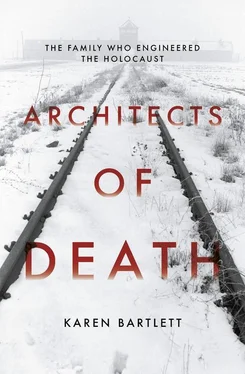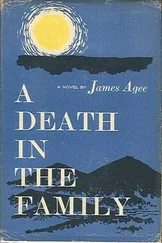My theatre career and journalism absorbed me completely – but of course I read all of the important books, like Eugen Kogon’s work on the SS system and the concentration camps. I was familiar with a lot of political literature. I had my own political education, but there was a big lapse of time before I could look into Topf and Sons in Erfurt.
The lapse Hartmut mentions refers to the decades when Topf and Sons continued to operate as a company in East Germany. There appears to have been no appetite, either under Soviet occupation, or East German rule, to account for the company’s role in the Holocaust (other than the rather strange criminal case of the 1950s, which was dismissed almost as soon as it emerged).
Under the leadership of Willy Wiemokli, who became the head of the company in 1946, Topf and Sons continued to make payments to the wives of Kurt Prüfer, Gustav Braun, Fritz Sander and Karl Schultze while they were under arrest in the Soviet Union, and in 1948 both Paul Erdmann and fitter Martin Holick received fifty-year anniversary commemorations for their dedicated services to the company. Payments to the wives of the four arrested men stopped when Topf and Sons became a state-run enterprise in 1949, and all mention of the war and working with the SS was whitewashed from the company’s history.
Until 1952, Topf and Sons was known as Topf Works VEB, but the company was renamed in 1952 to remove the Topf family name, and then again in 1957 when it became known as VEB Erfurt Malting and Storage Construction. The crematorium division had been closed down two years previously in 1955, with all drawings, documents and models sent to another company in Zwickau, and the new company focused instead on grain malting equipment which was exported to Eastern Europe and the Soviet Union, and then later to Libya, Angola, Cyprus and other countries sympathetic to East Germany.
Just as the old Topf administration building was still the heart of the company, the Topf family park was also still in use – housing a company clubhouse and restaurant in Ludwig Topf’s villa, and at various points, a hostel for apprentices, swimming pool and kindergarten in the grounds.
The expropriation of the Topf family park and villa is referred to in a 1980s company history, as an example of the triumph of the workers in beating their capitalist bosses.
When Hitler came to power, the company experienced a brisk upturn in productivity. It started producing parts for ships and aircraft, as well as grenades and cremation ovens. During the Second World War, the concentration camps were equipped with cremation ovens produced by ‘Topf and Sons’. However, the workers employed by the company at that time did not know what the ovens were being used for. They had only been told they were incineration ovens for animal innards. This inhumanity was only uncovered after the end of the war and the liberation of the prisoners from the concentration camps.
The company brochure continues with an account of the foreign workers forced to work for Topf and Sons during the war, stating: ‘The workers had to work under a piecework system so that the factory owner could hold orgies in his luxury villa, now the Erfurter Mälzerei- und Speicherbau clubhouse.’ Next to this statement is an illustration of Buchenwald and the oath of the Buchenwald survivors swearing to destroy fascism. [148] Schüle, op. cit., p. 300. 1980s company history of Topf and Sons written in GDR. AS footnote 89: Company timeline, p6f, ThHStAW, J. A. Topf & Söhne Erfurt Nr. 35, sheets 6f.
In such a way, the history of Topf and Sons had been rewritten to serve the propaganda of communist-controlled East Germany. Annegret Schüle writes that:
Even though the Topf fitters spent long periods of time in the camps; even though the mobile ovens were built in the Erfurt company and were returned there for repair; even though the staff involved spoke quite openly of the equipping of the gas chambers; this version of events, with its abstruse reference to the incineration of animal innards, declares the entire workforce collectively innocent [creating] the impression that the Topf villa, which was expropriated and placed at the disposal of the workers after the war, could now serve as a symbol that the oath taken by the Buchenwald survivors had now become reality at VEB Erfurter Mälzerei- und Speicherbau.
The fall of communist East Germany and the reunification of Germany in 1990 spelled the end for many state-owned enterprises – including the VEB Erfurt Malting and Storage Construction (EMS), the company that was once Topf and Sons. Now under the leadership of Gustav Braun’s son, Udo (who had finally surpassed his father’s achievements), EMS was placed under the administration of the ‘Trust Agency’ which sought privatisation. Ultimately, Udo Braun’s efforts ended in failure; the company was initially sold before it petitioned for bankruptcy on 19 June 1996.
‘They gave me eight months to find an investor in Germany who would be willing to buy Topf and Sons,’ Udo Braun says.
I accepted and did my best, because I didn’t want the company to die and people to lose their jobs. Lots had to leave anyway. Of the 700 employees only 100 stayed. Since I had spent my entire working life there, my heart was also in it. The company was bought. The new owner got 70 per cent, I got 10 per cent – that’s what they wanted – and there were two other partners. That went on for two or three years. We then found out that we didn’t have enough money to construct new premises since we were not allowed to sell land that we owned in order to finance it. So the inevitable happened. The investor had difficulties of his own and in 1996 a liquidator took over and filed for bankruptcy. That was the worst day for me, when I had to go to the court. But I had to do it. I had to take care of everything. [149] Author interview with Udo Braun.
The administration building where the Topf brothers and their engineers had plotted how to build the technology for mass murder fell into decay, the family park slipped into leafy ruin. In its final company history, written in the 1990s, EMS had not mentioned the period of the Second World War at all – but still some important documents remained in the company archives, including Fritz Sander’s memo about his patent application, and the note about the dispute with the SS over the missing blower. Other documents had been retained by the former East German state archive in the Document Centre for the Prosecution of Nazi and War Crimes where Western researchers could look at them under Stasi supervision. These papers formed the basis of a file that was used at one stage to try to persuade Hartmut Topf to become a Stasi agent – an offer he refused.
Hartmut had been visiting Erfurt and staying with his cousin Dietrich since the 1970s. During one of these visits he visited the concentration camp at Buchenwald for the first time:
I wanted to see what was left of the camp. That was the first time that I walked through the small crematorium building that Topf and Sons had built. It was a shocking encounter. You walk through a very sad environment, and I found it hard to digest. I think I was speechless for a while. I saw things that I’d only seen before in photographs or in the newsreels. Then I wanted to know more, but at that time there was nobody to ask, not in Erfurt and not anywhere else. [150] Author interview with Hartmut Topf.
Hartmut began piecing together his family history, discovering the Topf and Sons commemorative brochure and old letters, while at the same time reconciling his much more immediate relationship with his father.
I grew into researching and asking questions slowly, step by step. I knew that the Nazis had killed so many people and that Topf had played a part in building the machinery. And of course they earned a lot of money from the Nazis, and my first thought was that they should not have touched this dirty money.
Читать дальше












